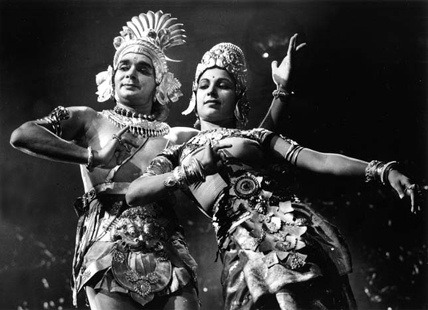|
|
| |
| Reviews |
| |
Lakshmi Shankar Shares Her Memories of Uday Shankar, Recalls His Legendary Film ‘Kalpana’
|
| |
 Image from “Kalpana,” 1948 Hindi film showing Uday Shankar and Amala Shankar. |
| Lakshmi Shankar was just 13-years-old when she made the long journey from the southern city of Madras (now Chennai) to Almora, Uttarakhand to join the Uday Shankar India Cultural Center. Her talent drew the attention of the legendary dancer and choreographer, who was recruiting dancers for a new cultural center and dance troupe that he was establishing in the foothills of the Himalayas. As a child, she was an avid student of Bharat Natyam and was transfixed when she first saw Uday Shankar perform. |
| |
| “First he came as Indra, in a three minute dance. He just looked like Indra,” she recalled to me. “Then he came as a snake charmer. My God, he just took the dupatta and held it like this (she sings and demonstrates snake charming). He looked so much like a snake charmer. And then he came as Bhasmasura – so fat and with a mustache. You don’t know that it’s Uday Shankar … Then he came as Shiva. You need four eyes to look at him, you see? Any role he did, he would look the role.” |
| |
| For the past several months I have been working on a biography of Lakshmi, the Grammy-nominated Hindustani classical singer who eventually became the sister-in-law of both Uday Shankar and his brother, famed sitarist Ravi Shankar. I’m excited about the opportunity to tell Lakshmi’s story because I believe she provides a perspective on the journey of Indian music to the West that has rarely been heard from: a female Indian musician who was part of that movement. But even before achieving fame as a classical singer, Lakshmi was a talented dancer. |
| |
| Given my research, I was delighted when the New York Indian Film Festival celebrated the 100th anniversary of the Indian film industry by highlighting several classic films, including Uday Shankar’s 1948 film “Kalpana.” |
| |
| Shankar both directed and starred in the movie alongside his wife and fellow dancer Amala, and a then 17-year-old Padmini. It was Shankar’s only film and the Festival program described it as “part soap-opera, ballet, and political treatise.” |
| |
| More than 70 years later, Lakshmi still has vivid memories of Uday’s performance. |
| |
| “His style … We would call it modern dance, modern style. He was the creator of all these modern (Indian) ballets,” she said. “There is not one modern (Indian) ballet without his movements. And he has actually taken it from the classical styles and made it his own.” |
| |
| In his autobiography “Raga Mala,” Ravi Shankar, whose fame and worldwide recognition would eventually rival Uday’s, extolled his brother’s artistic vision: “My brother always thought big, and the centre had been designed in an almost American style, covering the entire summit of a hill. There was a huge studio with a stage, dressing rooms, and working places, stores for costumes, a separate music studio, and special cottages for students and teachers. It was a grand affair, with many dancers and musicians, and a large number of staff.” |
| |
| Uday focused not just on innovating the broad concepts of Indian dance performance, but the very movements themselves, mixing elements of various dance forms but also creating signature movements of his own. As Ravi Shankar wrote, “[Uday] had already started his own dance techniques, creating wrist, palm, finger and hand gestures as well as neck, shoulder, waist and hip movements, many new leg movements and steps. His eye and facial expressions were highly influenced by Kathakali. His specialty was moving the whole arm like a wave.” |
| |
| Until now, I had only seen black and white photos of Uday in costume, striking dance poses. As I watched “Kalpana” unfold on screen inside Tribeca Cinemas, I finally understood how visionary Uday Shankar was as a dancer and as an artist. Just as Lakshmi had been as a young girl, I sat mesmerized by Uday’s powerful yet fluid, authoritative yet sensual, dance style. I watched as Uday transformed his arms into “waves” just as Ravi Shankar had described |
| |
| The black and white film is stunning in its blend of ballet and theater, and elaborate sets and costumes. However, it is just as revolutionary in the range of themes it covers: conformity and dogma versus innovation and freedom, art as a path to Utopia, greed versus artistic integrity, political rhetoric versus true civic duty, and feminism. None other than award-winning filmmaker Martin Scorsese spearheaded the efforts to restore “Kalpana,” recognizing not only its place in Indian film history but in the history of film as a universal art form. |
| |
| A few days after the screening, I called Lakshmi Shankar to share my thoughts. “Lakshmi Mami,” I said, “I finally understand all that you tried to explain to me about Uday Shankar’s dance style. It was amazing. I don’t think I’ve seen anything else like it.” She laughed and replied, “I know. Uday was just … he was just ahead of his time.” |
| |
| After fifteen years developing and leading innovative programs in the social change sector, Kavita Das now serves as a nonprofit consultant and writes nonfiction and creative nonfiction. Her work has been published in The Rumpus, Colorlines, Thought Catalog, DashAmerican, The Sun, and in an upcoming anthology by Telling Our Stories. You can connect with Kavita on Twitter @kavitamix. |
| |
| |
| |
| |
|
|
|
|

